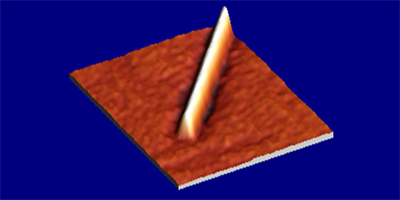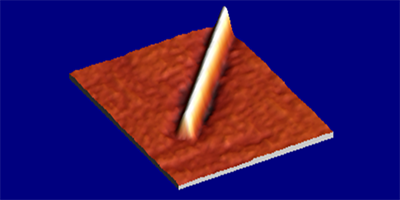Self-Elongating Nanowires
Traditional “top-down” methods for fabricating nanodevices are hampered by defects and other irregularities. Growing interest has therefore centered on bottom-up strategies that involve the self-assembly of individual components. As part of this trend, scientists have developed a novel method for producing germanium nanowires that, unlike previous efforts, can be grown directly on a microchip during fabrication without the need of any metal catalyst to drive the self-assembly.
Bottom-up fabrication is highly precise and reproducible, since the desired component is essentially built atom by atom. Semiconductor nanowires, for example, grow incrementally, like tiny plant shoots, with the help of metal nanostructures that concentrate the semiconductor material and then extrude it in a single direction. One drawback of this method is that the metal catalyst can contaminate the wire. Another is that integration of such vertically grown wires into silicon technology is extremely challenging.
To avoid this problem, Jianjun Zhang of the Leibniz Institute for Solid State and Materials Research in Dresden, Germany, and his colleagues developed a catalyst-free way to make nanowires on a flat surface. Using molecular beam epitaxy, they deposited a thin layer of germanium on a silicon substrate. They then annealed their samples at . The germanium first collected into well-known tent-shaped islands called “hut clusters.” But after a few hours, these islands stretched out to a few microns in length, while maintaining a height of roughly three unit cells (or about nanometers). Theoretical modeling showed that the wires grew because the tent shape reduces the surface energy of the germanium layer. The small and uniform cross section of the nanowires could make them ideal for certain devices, such as those that control the spin of the charge carriers. – Michael Schirber





